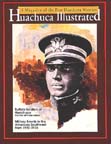 Huachuca
Illustrated, vol 1, 1993:
Huachuca
Illustrated, vol 1, 1993: Huachuca
Illustrated, vol 1, 1993:
Huachuca
Illustrated, vol 1, 1993:
chuca Illustrat
chuca Illustrat
Buffalo Soldiers at Huachuca:
Villa's Raid on Columbus, New Mexico
chuca Illustrat
The skirmishes and wayward gunfire from across the border which had occupied the 10th Cavalry's first two years at Huachuca were only prelude to what was to be the Buffalo Soldier's biggest and most dangerous undertaking since the Spanish-American War.
In neighboring Mexico, revolution was fissuring into counterrevolution. Francisco "Pancho" Villa's onetime partners in seeking to overthrow the usurper Huerta, Alvaro Obregon and Venustiano Carranza, no longer had any use for him. Villa, a champion of the peasantry, did not fit into their plans for a government which would curry the favor of the landed gentry. Once the most successful commander in Carranza's Constitutionalist movement and a leading contender for the seat of government, Villa now found himself harried by carranzistas and cornered in northern Chihuahua. His once powerful Division del Norte had been smashed at the battle of Agua Prieta on 1 November 1915 and the Carranza government regarded him as an outlaw. And it was to his old ways that he now reverted, leading his remaining followers into the sierras of his native Chihuahua where he had ridden with outlaw bands as a teenager. The guerilla/bandito was in a desperate situation.

Columbus, New Mexico, in 1916.
Adding to his sense of estrangement were the actions of the U.S. government which recognized the legitimacy of the Carranza government in October 1915. Villa believed, mistakenly, that Carranza had entered into a secret agreement with the U.S. that would make Mexico a protectorate of the U.S. The Americans, who once supported him and made much of him in their press, he now thought of as his betrayers.
Just as infuriating as the recognition of the Carranza regime, was the permission granted by the American government to transport carranzistas by U.S. rail. This happened several times in late 1915 and continued into 1916. One such occasion, which took place over October 29 and 30, saw 5,167 officers and men of the Constitutionalist army travel from Eagle Pass, Texas, to Douglas, Arizona, where they crossed over to Agua Prieta to reinforce the garrison there. This move turned the tide against Villa. Agua Prieta was Villa's Waterloo and the U.S. had materially aided in his defeat. These Mexican troop movements by American rail stirred the revolutionary's resentment and were believed to have been a major cause of his attack on Columbus, New Mexico.
Villa's growing hatred toward the Americans did not take long to make itself apparent. On 10 January 1916, villistas stopped a train at San Ysabel, took off eighteen American miners and engineers who had been assured safe passage by the Carranza government, lined them up, stripped off their clothes, and executed them. Villa, through emissaries, sought to deny blame for the San Ysabel massacre and claimed he would punish his subordinates who were responsible for the killings.
Meanwhile, Brig. Gen. John J. Pershing's headquarters at Fort Bliss, Texas, was receiving intelligence reports that Villa was near the border and intended to make an attack on U.S. territory that would cause the Americans to intervene, thus embarrassing the Carranza government. But rumors of anticipated border incursions were commonplace in those days and Pershing gave this report no credence.
The Tiger of the North
In fact raids on U.S. soil from across the border had occurred with alarming frequency. From July 1915 to June 1916, there were 38 raids on the U.S. by Mexican bandits, which resulted in the death of 37 U.S. citizens, 26 of them soldiers.(44)
Colonel Herbert H. Slocum, commander of the 13th Cavalry garrison stationed at Columbus, New Mexico, was also hearing reports of Villa's movements south of the border. A foreman at a nearby ranch rode in on 8 March to report that he had seen Villa around Palomas, just six miles to the south. But other observers contradicted this report and it was not investigated.
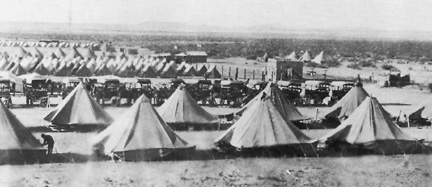
Military camp at Columbus, New Mexico, 1916. Photo courtesy Col. James W.
Fraser.
But Villa, the Tiger of the North, was out there. He was in camp at Boca Raton with some 485 of his men. After two of his officers returned from a walk around Columbus, New Mexico, on 8 March and said they thought there were only thirty American soldiers on the post, Villa saddled up his forces. At 4:00 in the afternoon the column moved north and sometime after midnight crossed the border. Deploying his men around the sleeping desert town, at approximately 4:00 a.m., the battle cry of "Vayanse adelante, muchachos!" was sounded and the almost 500 villistas swept into its sand-drifted streets. Yelling "Viva Villa!" and, according to some, "Muerte a los gringos!" they completely surprised the town and the garrison.
Upon hearing the first shots at about 4:15 a.m., the Officer of the Day, Lieut. James P. Castleman, ran to the guard tent, shooting a villista on the way, and turned out the guard. He then joined up with his F Troop, 13th Cavalry, which had been formed up by Sergeant Michael Fody. The camp and town were under a general attack from two directions.
Minutes later, Lieut. John P. Lucas, who had just returned on the midnight train from El Paso where he had been participating in regimental polo matches, saw a horseman ride by his window. He was wearing a high-peaked sombrero characteristic of the villistas. Hurrying outside, he joined the attackers who were running toward the barracks, the darkness concealing his identity. Gaining the barracks of his Machine Gun Troop, he led his men to the guard tent where their weapons were under lock and key. Despite several incidents of the French-made Benet-Mercier machine guns jamming, the four gun crews managed to loose 20,000 rounds at the enemy.
The Telling Blow
With the American defense organized and stiffening, and the sun coming up on the battleground, Villa broke off the attack and ordered a general retreat at about 6:30. He left behind at least sixty-seven dead. About thirteen others would later die of their wounds. Five Mexicans were taken prisoner.
It wasn't until 7:30 a.m. that all of the villistas had cleared the town. Villa with thirty riflemen occupied a hill southeast of the town to cover the retreat. Major Frank Tompkins mounted a pursuit that dealt the raiders a telling blow and earned for him the Distinguished Service Cross.
American casualties in the 9 March attack on Columbus included 10 civilians and 8 soldiers killed, 2 civilians and 6 military wounded, for a total of 18 killed and 8 wounded. A block-wide area in the center of town had been torched and burned to the ground, including the Commercial Hotel belonging to Sam Ravel, the man said to have double-crossed Villa in a gun deal.
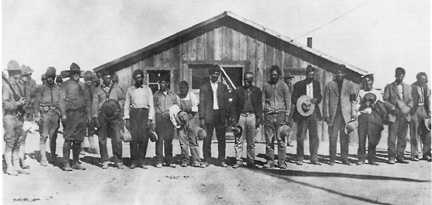
Villista prisoners at Columbus, New Mexico, in March 1916. Photo courtesy
Col. James W. Fraser.
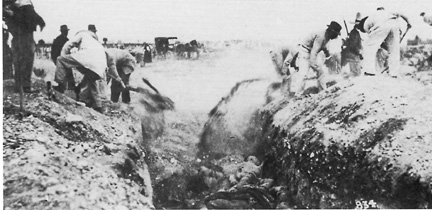
"One Grave for 63 Men After the Big Battle." Photo by W. H. Horne,
El Paso, Tex.

A clock in Columbus, New Mexico, stopped by a villista bullet at 4:10.
Setting the Record Straight
Newspaper headlines and unclear reports that followed the Columbus raid made it look like Villa had dealt a crippling blow to the surprised American garrison at this gritty little border hamlet. Major General Frederick Funston, commanding the Southern Department headquartered at San Antonio, Texas, felt it necessary to set the record straight in his 1916 Annual Report:
... Owing to the fact that a telegraphic report, filed by the District Commander, was lost by the operator in the excitement of the day and the hysteria produced by the fear of a return attack, the first accounts of this raid were received from the press associations thus creating an unfavorable impression on the public and official minds; but when it is realized that a force of from 500 to 700 men attacked a force of about 330 men in the dead of night, and that the attacking party was repulsed and driven off after about an hour's fighting, that it was pursued for nearly twenty miles with a loss of nearly two hundred men, that all this was accomplished with the loss of only ten men, the Columbus raid cannot be otherwise considered than as a very creditable performance by the troops engaged.
Much has been said about whether or not this attack was a surprise. If there was any person in the country who was not surprised at such an attack by a large body of armed troops coming from a nation with whom we are at peace, that person must have been one of those residents of the immediate vicinity, who were alleged to have known of the plans for the attack, or to have guided Villa's troops in the attack.. (45)

Part of the business district of Columbus, New Mexico,
1916.
Photo courtesy of Philip Howard Osborne, veteran of 1916 Punitive Expedition.
Several motives have been attributed to Villa for his raid on Columbus. One theory holds that it was a deliberate move to invite American intervention in Mexican affairs thereby making Carranza look like a lackey of the Americans and at the same time drawing government troops away from the beleaguered villistas. Another story has an American merchant in Columbus, Sam Ravel, refusing to sell Villa arms, reneging on a deal made earlier, and keeping the money already paid. Some think that the sole purpose was to wreak his vengeance on the hated Americans for their betrayal of his revolution. All of these supposed motives may have played some part in Villa's action on 9 March 1916, but, judging by the military results, the raid would seem to have been prompted by Villa's need of supplies, money and munitions. The attack on this isolated, lightly garrisoned outpost yielded from the 13th U.S. Cavalry's arsenal and stables loads of rifles, machine guns, ammunition and a herd of more than a hundred horses and mules.
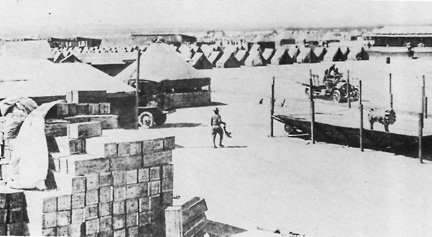
A camp at Columbus, New Mexico, in 1916.
Footnotes:
13. Buffalo Soldiers at Huachuca: Organizing the Punitive Expedition